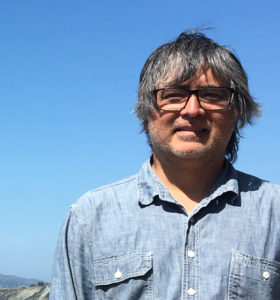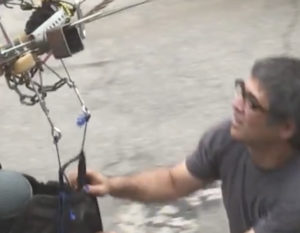

Aaron Glascock is a supervising sound editor, sound designer, and re-recording mixer with a long list of films behind him. To date he has received the MPSE Golden Reel for his work on War of the Worlds, an Oscar nomination for Birdman or (The Unexpected Virtue of Ignorance), and has received several other nominations. More recently, he has worked on Creed 2 and Chappaquiddick.
DS: Hi Aaron and thanks for joining us. Can you tell us about your background, how you got your start in audio, and how your career in film sound progressed to becoming a supervising sound editor, sound designer, and re-recording mixer?
AG: When I was young my dad worked on documentaries as a camera operator, editor, director and producer. The projects he worked on were tiny, but they had the most stimulating subjects and people surrounding them. My mom was an artist and freelance designer, often producing graphics for the films, doing print ads for camera companies. From this I had less of a film orientation and more of an open sense of work and creativity. The work was integral to life. The house was a staging point for the people and equipment. The equipment cases would be there the night before, gone in the morning, and at the end of the day the crew members would return and have dinner that night. Sometimes the living room would have a film editing bench and a Moviola. My uncle John was a production mixer. By the time I was 13, I was playing in a punk band. So being a drummer, I would need to work in order to afford to buy cymbals, which I was always breaking. Over the next few years I had many jobs, eventually I would work at my uncle’s tiny sound company, doing painting, maintenance etc. Eventually my job would be cross referencing sound effects in a database, on a Kaypro computer. This work experience would lead to what would be my first real sound job.
At seventeen, I was still intent on being a musician. I had just spent the past year playing in a band called America’s Hardcore, I was a drum tech for a then unknown band called the Red Hot Chili Peppers, and was playing drums in the hardcore punk band the Circle Jerks. My dad told me about a “real” sound company looking for a sound effects librarian and reminded me that I had rare qualifications. I interviewed and got the job. I thought it would be for the summer only, but it stuck. That was the summer of 1984. The next few years were spent listening to and learning the best sound effects library in the business. It would later become known as the Weddington fx library. Along the way I built sound effects props, recorded and cataloged sound effects into the library.
Eventually I became an assistant editor, in both sound and picture cutting rooms. Back in the “film” days, the sound editing house was chaotic. If you proved yourself at one discipline, you were probably about ready for the next. The work itself was the education. There was much social interaction working with film because the medium had so many stages in the work process, so many people. The assistant editor was a production manager. If you were interested, all of the information about the methods were right there to learn from. Everyone who was at the next level, had once been in your shoes. There were teachers everywhere.
Finally I started supervising. Supervising Editor George Simpson had a post schedule shift, and could not do one of the projects he had committed to. He was sure that I could do it. That first project was a documentary. To this day I approach every Supervising experience as an opportunity to have a new discovery. In a way, I approach the job as if it was my very first. It’s the best way to apply new meaning to the work. This is not difficult as no project resembles another, the solutions are so varied.
DS: The topic for the month is “hibernation”. Can you think of any specific examples of films where a special piece of sound design comes in early foreshadowing something, goes to sleep or hibernates throughout the film, and then comes back at the end? Can you tell us about the sound design for those films?
 AG: I love this idea. This process is the powerful opportunity to define time, event and place in the story line, and have the audience experience the way that definition shifts over its course. This process can unlock and open the viewer’s personal emotion during the course of a story. It uses the individual’s subconsciousness to maximize the story experience. A value that is revealed later to have greater significance is key. The individual’s reaction to the memory is always exaggerated in the moment of reflection, that’s a powerful feeling.
AG: I love this idea. This process is the powerful opportunity to define time, event and place in the story line, and have the audience experience the way that definition shifts over its course. This process can unlock and open the viewer’s personal emotion during the course of a story. It uses the individual’s subconsciousness to maximize the story experience. A value that is revealed later to have greater significance is key. The individual’s reaction to the memory is always exaggerated in the moment of reflection, that’s a powerful feeling.
Recently I worked on Creed II, where on screen there are moments of reflection that are supported by sound, and there are moments of reflection that stand on sound alone. They are very simple. Throughout the story we use sound to set up metaphors for legacy and the passing of the torch.
DS: Were there any special elements to that sound design? Is there a trick to getting it to work?
AG: The key is to not force it. Watch the story and feel it. It’s an emotional guidance. Watch it without any sound. Work with the picture editor and make the timing allow for sound to function. Sometimes you have to make room for it.
DS: When you worked on Creed II, did you revive elements from Creed or from the original Rocky movies? How did those elements come into play? Can you talk about the sound design for those movies?
AG: Because of the long Rocky movie legacy, Director Steven Caple Jr. was consciously trying to tell the Creed II story in a fresh way. The original Rocky (IV) movie sound was only used in some on-screen media references to Rocky’s earlier fights, and they are minor, but informative to the story. There are a few sound design moments in Creed II that reflect on Rocky’s past. They are clear, though not heavy handed. Melancholy and nostalgic in affect. These moments of sound design work because they are easily identifiable, and they have a subtle amount of processing. They do feel as if they were lifted from one of the original films. The work of finding their functionality involved the adjustment of processing, so using the original files would gain only the bragging rights. It was easier to make them from scratch.
 DS: I see that you worked on the film Ben-Hur in 2016. Did you go back and revive any of the sounds or elements from the original Ben-Hur that have been hibernating all of these years?
DS: I see that you worked on the film Ben-Hur in 2016. Did you go back and revive any of the sounds or elements from the original Ben-Hur that have been hibernating all of these years?
AG: The process of working in sound, as we do in motion picture sound design, is one of aural visualization, followed by the creation and/or the re purposing of media. It’s kind of like a mathematical collage. The original form of a sound element can be completely obscured when it’s working with many components. We are finding ways to stimulate, rattle and disrupt the idle listening environment. We are seeking a result with no limits on the effort to energize it. Because of this, anything can be part of getting there. Sound effect libraries are resources in hibernation. For example, we recorded several horses and chariots for Ben-Hur. They were well recorded, but they did not sound like horses at the edge of fatal danger. They did not have a sense of destructive energy. I ended up seeking and listening to old effects recordings. I compiled a library of old horses that were then further processed into an aggressive, more dangerous sounding result.
DS: How is it working with sounds that have been in hibernation for so long? Can you talk about that process?
AG: This is so much of what we do every day. It’s not flashy. This method is without popular buzzwords. Without a doubt, it is the foundation of the entire sound design process. The method is critical to how all audio gets to the resulting presentation.
To this day, I can find a purpose for something that was recorded 30 years ago. The process uses the identifying sound effect name only so that it can be found. The effect name, or description, is only a shell compared to its potential. Its use is based on the way that it performs in the mix.
DS: Flipping things on their head, you worked on Insomnia back in 2002, which is the opposite of hibernation. Can you tell us about the sound design for that movie and how you created the feeling of not being able to sleep?
AG: Insomnia was threaded with tonal sound design. The score-like tone would ripple and ring as Detective Dormer (Al Pacino) would slide deeper into his fogged insomnia. The profile of some events and objects would drive the saturated yet empty feeling of sleeplessness. Chris Nolan had a great sense of how to drive this effort as the sound process was coming together. Insomnia’s other characters had clarity in their environments and details, Dormer’s were cluttered with blurriness. The rocky shore line sequence, a moment that precedes his insomnia, is where he shoots his partner. Though he is not losing sleep yet, it’s as if he enters the vulnerability to Alaska’s long day. This is his where his mind starts playing tricks on him. As he falls deeper it’s very much like a house of mirrors. He becomes haunted by old and recent actions.
DS: Do you have anything that you would like to add? Any advice for new people just starting out?
AG: I would suggest to anyone trying to do this work to first develop an ability to discuss the sound medium. The sound itself is a language. It’s very expressive. Try making your own sounds, try walking your own foley, boom some dialog, try mixing – if only to understand the value of the work. Always record and maintain a library. Work with people trying to make movies, people just starting out. I still do this now.
Work on difficult projects. To this day, as I work on developing sound design on a film, I am trying to make the work more challenging. I am looking for a meaning to express that is not so apparent. If it’s easy, you’re missing something, because the sound designer’s job is to bring more to the story. Each and every one of these movies has never been done like this before.
But, you have to make it that way.
With our extensive collection of elements, creating and customizing layouts becomes
second nature. Forget about coding and enjoy our themes.